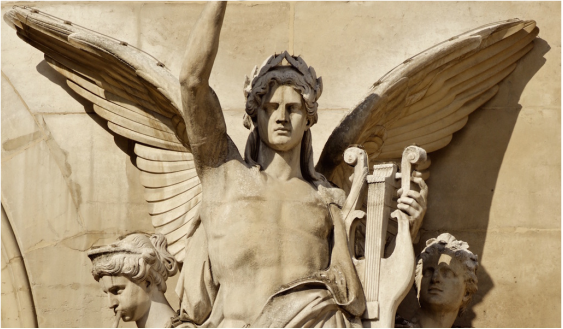As such, the European Union Choir is proud to present the opera concert dedicated to some of the best choral parts ever to have found their way into an opera score. READ MORE...
| Beautiful(ly) simple music In chronological order, the first to step up is Orfeo ed Euridice by Christopher Willibald Gluck, a work characterised by beautiful(ly) simple music and by a libretto of acute emotions. Speaking about love transcending the borders of life, Orfeo, dating from 1762, represented many of Gluck’s revolutionary ideas: the lack of cadenzas for soloists to show off, or the placing of the libretto, as the true projector of the drama, above the music. “Che farò senza Euridice” is actually an aria, but what can be more moving than having 80 voices sound the plaint of Orpheus after losing his wife Euridice? Trying to save his theatre from bankruptcy Wolfgang Amadeus Mozart’s Die Zauberflöte shares with Orfeo the concept of a protagonist confronted with difficult times in dark regions. The composer wrote this opera at the request of his friend Emanuel Schikaneder trying to save his theatre from bankruptcy, and it seems to have been very well received at its first performance in 1791. In “O Isis und Osiris”, the priests of Sarastro, sovereign in a kingdom of light, pray that these gods (symbols of the ideal mother, and of the afterlife and fertility, respectively) help the hero overcome all obstacles he has to face. Inspired by a folk tale Carl Maria von Weber (whose cousin Constanze had married Mozart) presented his opera Der Freischütz to an enraptured Berlin audience in 1821. Inspired by a folk tale, the story involving supernatural events unfolding in the ever mysterious forests blended with an extremely expressive musical language; having set “the German people’s pulse racing” at its glorious premiere in 1821, Der Freischütz freed the opera genre from under the Italian/French rule and marked the birth of German Romantic opera. Today you will listen to the “Huntsmen’s Chorus”, whereby the hunters sing the joys of their trade. Italians’ unofficial national anthem There are several excerpts from Giuseppe Verdi’s operas in our concert. Nabucco, on episodes from the Bible, was first heard in 1842; Verdi’s previous stage work had been a failure, so the composer, questioning his musical abilities, was very reluctant to begin work on another opera. Even after he was persuaded to take a look at Nabucco’s libretto, writing evolved slowly and painfully. When, finally, though, the opera hit the stage of La Scala, it made the composer an overnight celebrity, and “Va, pensiero”, the Hebrew slaves chanting their longing for their fatherland, turned into the Italians’ unofficial national anthem. January 1853 saw the premiere of Il Trovatore, the tragic story which mingles the implausible with the passionate and a beautiful music with an outrageous plot, a hard blow on the audience’s need for order and beauty. The opera calls for singers who master virtuosity, expression, and acting. | "La Traviata, booed at its premiere in 1853, is now the most performed opera worldwide." Programme Excerpts from Carmen, Bizet Zauberflöte, Mozart Freischütz, Weber Orfeo, Gluck Tannhaüser, Lohengrin, Wagner Faust, Gounod La Traviata, Il Trovatore, Nabucco, Aida, Verdi Les Contes d'Hoffmann, Offenbach Cavalleria Rusticana, Mascagni The European Union Choir Ensemble Orchestral Mosan Dirk De Moor & Jean-Pierre Haeck, dir. Ana Rodriguez, actress June 4th Palais des Beaux-Arts de Charleroi Place du Manège 1 6000 Charleroi Contact Press EVENT ON FACEBOOK |
German legends, Greek mythology and mediaeval chivalry
Conducting his Tannhäuser in 1845, Richard Wagner had some trouble convincing his audience on the musical and dramatico-linguistic value of this 4-hours long opera. The story with elements of old German legends, Greek mythology, mediaeval chivalry, and romance, set to a music at times so passionate it made its very composer ill while writing it, must have been difficult to handle at first; but after some revisions Tannhäuser became (and stayed) a success. “Beglückt darf nun dich, O Heimat, ich schauen”, chant the pilgrims as they return from Rome, where they had been asking for forgiveness of their sins.
Faust's best know melody
Refused for being flamboyant enough, enjoying only a moderate success at its first performance in 1859, Faust was reworked by Charles Gounod into a masterpiece showcasing his ability to create a wealth of beautiful melodies and a highly particular orchestration. The “Soldiers’ Chorus”, praising their ancestors and looking forward to being reunited with their fiancées, is one of Faust’s best known melodies.
" Georges Bizet greatly admired Gounod’s Faust – the music he wrote for the character Micaëla in his Carmen was even attacked for being “Gounod-esque” "
“Gounod-esque”
Georges Bizet greatly admired Gounod’s Faust – the music he wrote for the character Micaëla in his Carmen was even attacked for being “Gounod-esque” (the older composer might have been in a condition to give his own verdict, as he attended the 1875 premiere). Shocking its bourgeois audience with portrayals of amoral, smoking in public women and of military deserters, as well as with its brutal end, Carmen lived on to become one of the most beloved lyrical works. “Les voici!” is the song of the crowd as the bullfighters arrive.
“Belle nuit, ô nuit d’amour”
Humans falling in love with automata or mysteriously ill singers (the play written by librettists Jules Barbier and Michel Carré after stories by E. T. A. Hoffmann). With music ranging from vaudeville to refined lyricism, the opera was left unfinished: Offenbach died before its premiere in 1881. The barcarolle-duet “Belle nuit, ô nuit d’amour”, accompanied by a wordless chorus, harmonious and simple, renders all the more evident the sinister feel of the act it is part of (...)
Programme notes on the composers compiled by
Geneviève Ralet - member of the EU Choir
Programme notes on the works compiled and written by
Maria Monica Bojin - member of the EU Choir
Copyright "The European Union Choir'
March, 13 - Royal Music Conservatory Brussels
The European Union Choir
Ensemble Orchestral Mosan
Jean-Pierre Haeck & Dirk De Moor, dir.



 RSS Feed
RSS Feed